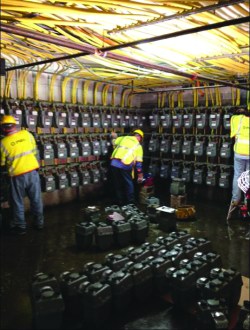
Within an hour on the morning of Jan. 21, a major energy transportation company experienced a rupture to a gas transmission pipeline in Ohio and an equipment malfunction in Rhode Island. The first incident severely injured two people and damaged area homes while the second precipitated a gas outage for more than 10,000 people. In winter’s cold, no one wants to be without heat, or worse, injured in a gas incident.
In the Rhode Island towns of Newport and Middletown, millions of dollars were spent to reimburse or provide hotel rooms, meals and space heaters for thousands of residents while gas restoration efforts took up to seven days for most and longer for others. Nearly 1,000 gas service professionals and the National Guard responded to the incident.
At PSE&G, our core commitments to safety and continuous improvement have helped us plan for the unexpected. As part of our Energy Strong II proposal currently before the New Jersey Board of Public Utilities, we created natural gas delivery programs designed to increase our system’s safety and reliability while minimizing risks to our customers and New Jersey’s economy.
The largest of the programs would help us move gas supply to areas of the service territory more vulnerable to service interruption by an interstate gas pipeline supply shutdown or curtailment. The other program would modernize seven metering and regulation (M&R) stations as well as harden two stations that also are in flood zones.
We believe it’s prudent to make these investments now before there are new threats and while current bills for a typical gas residential customer are approximately half what they were 10 years ago.
Gas Curtailment
A major interstate pipeline curtailment during cold winter weather could have widespread and prolonged consequences and cause significant harm to customers and to New Jersey.

PSE&G experienced an interstate gas pipeline curtailment due to a rupture of a gas transmission pipeline in Pennsylvania on April 29, 2016. As a result, four parallel gas transmission pipelines in the vicinity were shut down within one hour. The pipeline owner declared a “force majeure” and reduced its supply. The initial reduction was approximately 78 percent for 11 days, at which time the curtailment was reduced to about 39 percent for the next-five-and-a-half months while repairs continued.
PSE&G was able to operate its gas system for the six-month duration of this interstate pipeline curtailment without an impact to most customers due to relatively low gas demand from April through October. If the curtailment had occurred in mid-winter, however, PSE&G may have initially interrupted service to more than 250,000 customers and potentially more than 400,000 customers as available supplies depleted.
Once a curtailment is lifted, the safe restoration of service to customers who have been without gas is a time-consuming process that would add weeks, if not months, to this timeline. For example, after Superstorm Sandy in 2012, it took PSE&G 12 days to restore gas service to more than 6,250 customers. After Hurricane Irene in 2011, it took 10 days to restore service to more than 10,000 customers. In both cases, we had customers who remained shut off longer due to significant foundation damage, municipal inspections or replacement of customer equipment.
Any substantial prolonged curtailment would have severe impact to the New Jersey economy since large industrial and commercial customers would be curtailed first, effectively shutting down many of these businesses. Our Energy Strong II plan would substantially reduce these potential risks.
M&R Station Upgrades

The life cycle upgrades are intended to modernize the operation of M&R stations placed in service decades ago, including stations in Camden, East Rutherford, Edison, Hillsborough, Mount Laurel, Paramus and Westampton.
The modernization enhances the safety, reliability and resiliency of the system and delivers many specific benefits, including our ability to maintain service reliability, harden stations against flooding where applicable, reduce the likelihood and consequence of equipment failure, and implement modern design practices to reduce the potential for methane emissions.
Safety standards and regulation are stronger than ever. Timely and proper infrastructure investments, such as those proposed under Energy Strong II, continue to position PSE&G as a leader in the gas industry.





Time for all Natural Gas utilities to start phasing out the use of natural gas in favor of electric heat pumps for building heating and hot water. The electric heat pumps can then be supplied with electricity from solar and wind generation.
Wind mills could never even recover the cost to build and maintain them. Solar power to run heat pumps? Do you understand what a heat pump is? The Air Conditioning system reversed, running a heat pump for your home alone would require most if not all of your roof panels and when the sun isn’t out, cloudy or overcast, then overnight are you going to live with no heat, no hot water and no electric? Natural gas is cheap, efficient and plentiful, with high efficiency units they don’t emit little to no CO.
meter change